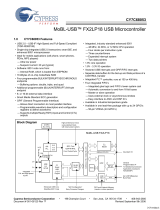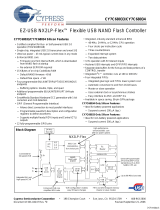Page is loading ...

Providing Power for EVTEK-5103: 1) If the main power input is used, connect the MASCOT 8717 plug
2) If the auxiliary power input is used, connect a standard 9 V battery
Choosing EVTEK-5103 Operation Modes:
Switch Position:
MSB (* mid (* LSB (*
Mode
nr.
Corresponding Operation Mode:
Terminal
Response:
LO LO LO
0 Receive a file from PC to Board RAM “(enter)RCV:“
LO LO HI
1 Transmit a file from Board RAM to PC “(enter)TMT:“
LO HI LO
2 Copy lowest 32 kB RAM to EEPROM “(enter)R2E:“
LO HI HI
3 Copy 32 kB EEPROM to lowest RAM “(enter)E2R:“
HI LO LO
4 Start executing program code from 4000h “(enter)EXC:“
HI LO HI
5 Stand-alone – does first mode 3, then 4 “(enter)S-A:“
HI HI LO
6 Board’s Embedded Debugger CLI Tool “(enter)DBG:“
HI HI HI
7 Test mode – blinks Board’s I/O-ports “(enter)Test“
(* when seen from the front, MSB switch is the rightmost, and LSB is the leftmost
Implementing Serial Connection:
Connect the EVTEK-5103 Board’s serial port 1 and PC’s available serial port with a cross-connected serial cable
Interfacing the EVTEK-5103 from a PC:
It is recommended to use the “EVTEK-5103 Interface” application, that is specifically made for this purpose. The
user guide for the application: START MENU Æ PROGRAMS Æ EVTEK-5103 Æ INTERFACE MANUAL
If using a terminal program instead of “EVTEK-5103 Interface” application:
Use Hyperterminal (not under Windows 2000), or Tera Term http://hp.vector.co.jp/authors/VA002416/teraterm.html
Terminal Program Connection parameters:
Baud rate = 57600 kbps Data bits = 8 Flow control = none
Parity = none Stop bits = 1 COM port = the one you’re using on PC
Enter key = CR+LF Local echo = no Destructive backspace = yes
Also, set terminal scrollback buffer to at least 500 lines for convenience of use.
EVTEK-5103 Board’s Programmable Peripheral Datasheets:
8051
CPU:
AT89C55WD http://www.atmel.com/dyn/resources/prod_documents/DOC1921.PDF
DS89C420 http://pdfserv.maxim-ic.com/arpdf/DS89C420.pdf
UART: TL16C552 http://focus.ti.com/lit/ds/symlink/tl16c552a.pdf
PIO: M82C55A http://www.okisemi.com/datadocs/doc-eng/msm82c55a_2rs.pdf

Overview of the EVTEK-5103 address space:
Hex Address: Address Contents:
0000…1FFF External EPROM (contains the operating system of the Board)
2000…27FF Aux /CS (* = 0 for Serial port 1 Aux /CS (* = 1 for Serial port 2
2800…2FFF Aux /CS (* = 0 for Printer Par. Port Aux /CS (* = 1 for Mode Switches
3000…37FF Aux /CS (* = 0 not used Aux /CS (* = 1 for Parallel Ports 1 & 2
3800…3FFF Aux /CS (* = 0 not used Aux /CS (* = 1 for Parallel Port 3
4000…B3FF External RAM: free area to be used as program or data memory
B400…B5FF External RAM: IE0 Interrupt Vector
B600…B7FF External RAM: TF0 Interrupt Vector
B800…B9FF External RAM: IE1 Interrupt Vector
BA00…BBFF External RAM: TF1 Interrupt Vector
BC00…BDFF External RAM: RI & TI Interrupt Vector
BE00…BFFD External RAM: TF2 & EXF2 Interrupt Vector
BFFE…BFFF External RAM: RESERVED for operation modes 0 and 1
C000…FEFF External RAM: free area to be used as program or data memory (**
FF00...FFFF External RAM: RESERVED for operation mode 6 (**
14000…1FFFF External RAM Upper page: free area (***
I2C: 0000…7FFF External Serial I2C EEPROM: RESERVED for operation modes 2 and 3
I2C: 8000…FFFF External Serial I2C EEPROM: Free area, not implemented (****
(* Aux /CS refers to Auxiliary Chip Select (P1.7) line used with the Board’s memory mapped I/O addressing.
(** this external RAM area is not copied or overwritten when operation modes 2 or 3 are executed
(*** it is possible to address upper 48 kB page of external RAM by setting the memory page select jumper to RAM page select
allowed position and setting P1.6 high.
(**** When appending the second I2C EEPROM to the system, N.B. device address code implementation is required from both
EEPROM chips. Also OS I2C routine device addressing requires update.
EVTEK-5103 address space harnessed 8051 port pins:
Pin nr Pin name Reserved pins function: Dir
P1.0 T2 I2C SCL (Serial Clock line) Out
P1.1 T2EX extra interrupt /INT2 from the 16C552 Printer Par. Port In
P1.2 I2C SDA (Serial Data line) Bi
P1.3 I2C EEPROM WP (Write Protection bit) Out
P1.4 16C552 PEMD (16C552 Printer Par. Port specific bit) Out
P1.5 16C552 /ENIRQ (16C552 Printer Par. Port specific bit) Out
P1.6 SRAM A16 (page select) selection bit Out
P1.7 Aux /CS (Auxiliary Chip Select bit) Out
P3.2 /INT0 External interrupt /INT0 – 16C552 Serial port 1 In
P3.3 /INT1 External interrupt /INT1 – 16C552 Serial port 2 In
/EA External Memory Access (tied to GND) In
EVTEK-5103 Programming instructions:
1) Start your program with a “.ORG 4000h”.
2) Open a DOS prompt window in the directory where your *.asm files are located
3) Compile your assembler source code to object file with command A51 filename (no “.ASM” needed)
4) If errors were found, you can type EDIT filename.LST
5) compile the *.OBJ –file to binary file with command HEX2BIN /O-16384 filename.OBJ filename.BIN
N.B: You can download MCS-51 Microcontroller Family User’s Manual from www-address ftp://download.intel.com/
design/mcs51/manuals/27238302.pdf
. Chapter 2 contains the 8051 Programmer’s Guide and Instruction Set.
Debugger: Type a question mark ‘?’ to display the help file.
EVTEK-5103’s areas reserved for the Debugger (Board operation mode 7):
Location: Register Notation Function
8051 SFR TCON bits 6 and 7 TCON.6, 7 8051’s Timer 1 run ctrl bit & OV flag
8051 SFR Port 3 bit 2 P3.2 External Serial Port 1 interrupt input pin
8051 SFR Port 1 bit 6 P1.6 SRAM page select bit
8051 SFR PSW bits 3 to 5 PSW.3,4,5 Reg. bank selectors & g.p. user flag
8051 SFR IE bits 3 and 7 IE.3, IE.7 8051’s Timer 1 OV INT & EA
8051 SFR IP (all bits) IP 8051’s Interrupt Priority Register
8051 SFR TMOD bits 4 to 7 TMOD.4,5,6,7 8051’s T1/C1 mode control register
8051 int. RAM
Stack pointer uses 8051’s indirect internal RAM locations 80h…FFh stack space
External RAM Memory locations FF00h…FFFFh (breakpoint stack etc.) and BA00h…BA02h (Timer 1 INT
vector)
/

